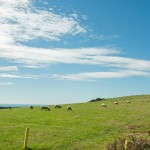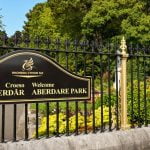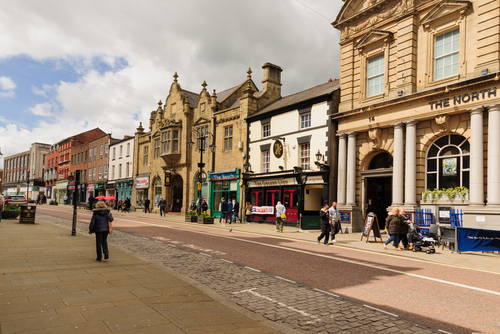
A quick guide to Wrexham!
Wrexham is a regional administrative, commercial and educational centre, as well as being the largest town in North Wales Wrexham. It is situated between the Welsh mountains and the lower Dee Valley alongside the border with England. The town lies 40 miles south of the major English city of Liverpool and 13 miles southwest of Chester. At the 2011 Census, Wrexham’s population was recorded at 65,692, making it the 4th largest urban area in Wales.
A Fleeting History
Human activity in the Wrexham area can be traced as far back to prehistoric times of around 8000 BC. In the 1st century AD, the Romans established a civilian settlement in the Plas Coch area of Wrexham.
By the end of the 6th century AD, the local Celtic speaking peoples were facing increasing territorial challenges from the Anglo-Saxon invaders who were advancing from the east. The Anglo-Saxons eventually annexed North Wales, ruling there between the 8th and 10th centuries. The original settlement of Wrexham was founded on the banks of the River Gwenfro by the Anglo Saxon interlopers sometime during the 8th century. However, repeated insurgencies throughout the 10th century, by both the indigenous Welsh and Britain’s new invaders, the Vikings, led to a gradual erosion of Anglo-Saxon power in North Wales. During the 11th century, the Welsh reconquered the area and Wrexham became part of the Welsh lordship of Maelor.
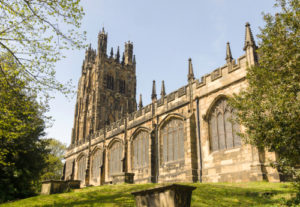
St Giles Church, built in 1492, is often described as one of the ‘Seven wonders of Wales’
However, by the mid-12th century, Wrexham had once again changed hands. Around 1150, Norman aristocrat, Hugh de Avranches, Earl of Chester built a ‘motte and bailey’ castle at ‘Wristlesham’. But, by the early 13th century Wrexham was under the control of the Welsh house of Powys Fadog. A period of stability enabled Wrexham to develop as both a trading town and an administrative centre. In 1202, Madoc ap Gruffydd Maelor, Lord of the Manor, donated some of his lands in Wrexham to Cistercian monks for them to build an abbey, which was completed around 1220. After that Wrexham was split in two, with one part being known as Wrexham Abbot, and the other as Wrexham Regis (of the king).
Even up until the late 14th century, Wrexham was still little more than a village, with a population of perhaps a few hundred. However in 1391, as an indication of its growing importance, Wrexham was granted a charter to hold a weekly market and an annual fair. In 1492, St Giles’ Parish Church was built, though its famous steeple wasn’t completed until 1506.
The Acts of Union passed during the reign of Henry VIII, saw Wrexham under English administration and law. In 1536, Wrexham became part of the new county of Denbighshire.
By this time Wrexham was still predominantly agricultural, but tradesmen such as weavers, smiths, nailers and cloth dyers, were all common.
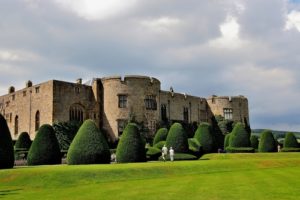
The magnificent Grade I listed Quirk Castle was built circa 1295 by Roger Mortimer de Quirk
In 1642, during the English Civil War, Wrexham like almost the rest of Wales sided with the Royalists. One exception was local landowner Sir Thomas Myddelton, owner of Chirk Castle, who supported Parliament. On 9 November 1643, parliamentary forces captured Wrexham without facing resistance.
By the beginning of the 18th century, Wrexham had become known for its leather industry and nail making. Nonetheless, by the middle of the century, Wrexham was still a small market town with a population of no more than 2,000. However, the arrival of the Industrial Revolution, in the late 18th century, was about to transform Wrexham. In 1762, local entrepreneur John Wilkinson (1728-1808) known as ‘Iron Mad Wilkinson’ opened an iron foundry at Bersham. This was eventually followed up by the opening of a smelting plant at Brymbo in 1793.
From the late 18th century onwards, large-scale industrialisation of some of North Wales’ coalfields took place. The new ‘super’ pits operated in tandem with hundreds of traditional, manually-worked, small-scale, family-owned pits, a mining practice which dated back to the Middle Ages.
By the early 19th century the long-standing wool industry had died out, but other industries such as coal mining began to boom. Bersham colliery opened in the 1860s, and new industries such as brewing, steelmaking and brickmaking became established. Leather manufacturing continued to flourish and expand, but by 1801, the population of Wrexham was still only around 2,500.
By 1851, the population of Wrexham was 6,714; but within thirty years it had increased to 10,978 as the town became increasingly industrialised. Also during the 19th century, Wrexham’s ready supply of potable made it attractive to the brewing industry. By the middle of the century, there were 19 breweries in and around the town. In 1881, one of particular note was established, the Wrexham Lager Brewery in Central Road, as it was the first brewer of lager beer in the UK. In addition to brewing, tanning was by now one of Wrexham’s main industries.
From the dawn of the 19th century, life in Wrexham began to improve for many. In 1827, gas lighting began to light up the town. In 1833, the first hospital opened, and in 1848, the Market Hall was completed. In 1863, a volunteer fire brigade was established in the town. In 1864, Wrexham Waterworks Company was founded, providing the town with piped water for the first time. And, from 1876 onwards, horse-drawn trams were running on the streets of Wrexham. The first public library in Wrexham opened in 1878. Overton Arcade was built in 1868 and the opening of Central Arcade followed in 1891. In 1907, Wrexham got its first public park, while electric trams replaced the horse-drawn variety. In 1910, the first cinema in the town opened.
By 1913, the North East Wales coalfield was producing up to three million tonnes of coal a year and employing over 10,000 people. However, the local coal industry went into decline after WW1, such that by 1946, there were only seven large-scale collieries operating in the Wrexham area.
In the 1920s and 1930s, Wrexham council, like many town and cities around Britain, began the work of slum clearance to create an area for new housing. A new council house estates were built at Acton Park, Spring Lodge and Maes Y Dre. And, in the 1950s, new council estates were built at Queens Park and Bryn Offa.
During WW2, Brymbo Steelworks was seen as being vital to the war effort in its capacity to produce top-quality steel. Although difficult to blackout, the Steelworks and Wrexham, in general, managed to largely avoid ariel bombing attacks by the Luftwaffe.
Modern Era Wrexham
During the latter half of the 20th century, Wrexham fell into a period of decline that saw little investment. Though the last pit in the Wrexham area, which was Bersham Colliery, didn’t close until 1986, the coal mines start a long programme of closure in the late 1940s. Wrexham’s famed brick industry largely came to an end in the late 1970s, and Brymbo Steelworks ceased production in September 1990.
In the 1980s and 1990s, the Welsh Development Agency (WDA) funded the A483 dual carriageway project, which by-passed Wrexham, but gave the town much greater connectivity with England’s principal road network. New shopping areas were built at Henblas Square, Island Green and Eagles Meadow.
Declared an industrial park in the 1970s, Wrexham Trading Estate has now grown to cover more than 550 hectares and is the largest industrial estate in Wales, second only in the UK to Trafford Park, one of the largest industrial estates in Europe. There are around 300 businesses based at the estate, providing employment for approximately 8000 people. The estate also houses the UK’s largest prison, HM Prison Berwyn, which opened in 2017.
In the 21st century, Wrexham is still in the midst of developing. The Border Retail Park opened in 2002, and the Eagles Meadow Shopping Centre opened in 2008.
Getting there!
By Road
The A483 is the principal route to Wrexham, connecting with the major roads A55/M53 to the north, and A5/M54 to the south. The A5156 leads to the A534, which connects with the M6, just north of Stoke-on-Trent. The A525 passes through the town running in a northwesterly direction from Stoke in the Midlands to Rhyl on the Welsh coast.
By Air
The nearest international airport to Wrexham is Liverpool, which is about 37 miles away. However, Manchester Airport, with a much greater choice of international destinations is only 46 miles away. There are frequent buses and trains, between both Manchester and Wrexham, and Liverpool and Wrexham, with a journey time of 2 – 2.5 hours.
By Bus
National Express operates a cheap and frequent coach service to Wrexham from many major destinations across the county.
By Train
There are 2 railways stations in Wrexham. The mainline station is Wrexham General. Wrexham Central, the terminus on the Borderlands line, serves northeast Wales and Merseyside.
The fastest trains between London Euston and Wrexham take around 2.5 hours, covering a distance of approximately 163 miles (260 km). Trains run approximately every 40 minutes between 6 am and 11 pm. From the Midlands and the North, you can easily get to Wrexham via Chester.
Did you know?
Did you know that the Pontcysyllte Aqueduct near Wrexham is both the longest and highest aqueduct in Britain? The World Heritage structure, built by Thomas Telford in 1805, basically a cast-iron trough, is well over 305 m long and fixed-in-place some 40 m above the ground.
An infamous son
In 1648, George Jeffreys was born at Wrexham’s Acton Park, the son of John Jeffreys and Margaret Ireland. Following the path of his grandfather, but very much against the wishes of his parents, the young George decided on a career in law. Educated at Shrewsbury, then St Pauls Westminster, and finally Cambridge, he began his law studies at the Inner Temple in 1663. He was soon appointed Solicitor-General to the Duke of York, the future James II, and was knighted in 1677. At the age of only 33, he became Lord Chief Justice of England and a privy councillor. Just two years later, he was appointed Lord Chancellor, and in 1683, he was made Baron Jeffreys of Wem.
In 1685, Jeffrey’s presided over ‘The Bloody Assizes’, a series of trials that followed in the aftermath of the Battle of Sedgemoor, which ended the Monmouth Rebellion in England. Following the trials of more than 1,400 supporters of the Duke of Monmouth, Jeffrey’s was dubbed the ‘Hanging Judge’ after the punishment that was metered out to those on trial. In 1688, after James II had fled the country, Jeffreys was placed in the Tower of London for his own safety. The following year, whilst still incarcerated, aged only 44 years old, he died of kidney failure, caused by a life long complained of bladder stones.
Wrexham AFC
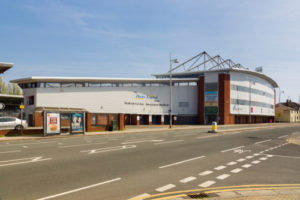
Wrexham AFC’s Racecourse Ground
Wrexham Association Football Club is a professional football club that plays in the National League, the fifth tier of the English football league system. They were relegated from the English 2nd Division, the 4th tier of English football, at the3 end of the 2007/08 season. They were formed in 1864, and are the oldest club in Wales and the third oldest professional football team in the world. Since August 2011 Wrexham have been a supporter-owned football club.
Wrexham’s home stadium, the Racecourse Ground, is the largest stadium in North Wales and the world’s oldest international stadium that still continues to host international games. As well as football, the ground had also hosted international Rugby Union and Rugby matches.
Things to see and do!
- Chirk Castle – the imposing medieval fortress near Wrexham complete with dungeons, murder holes and staterooms. There are also play areas and a family activity room.
- Alyn Waters Country Park – There are woodland, grassland, riverside walks, a cycleway, sculpture trail and adventure playground.
- Erddig – early 18th-century country house set in cultivated gardens and parkland. Displays include those detailing life in the house, above and below stairs, during Edwardian times.
- Grove Park Theatre – located in the town centre, programmes include drama, comedy, musicals, children’s shows and seasonal pantomime at Christmas. There are also weekly performance workshops for those aged 10 years and over.
- Pontcysyllte Aqueduct – part of a World Heritage Site, you can cross the Thomas Telford designed aqueduct by canal boat or join a guided canoe trip, which includes Chirk Aqueduct, the

Pontcysyllte Viaduct, designed by Thomas Telford, is both the highest and longest in Britain
Tunnels and Horseshoe Falls.
- Pony & Quad Treks – explore the beautiful Ceiriog Valley on horseback or by quad bike. Great alternative family day out, although the minimum age for quad biking is 12 years.
- Plas Power Adventure – the adrenalin-fuelled activities include; climbing, high ropes, karting and bushcraft. Great for families, groups and parties. Advance bookings only.
- The Plassey – a retail village with a real difference! Featuring a nature trail, a castle-themed play park, a zip wire, craft workshops, pitch and putt golf and a conservation lake, there’s plenty to do besides shopping.
- Wrexham Museum – presents the area’s history from the earliest times up to the present day. The family-friendly gallery has audio-visual and interactive displays and exhibitions.
Places to stay?
There’s a decent choice of accommodation in Wrexham which should suit most budgets. A broad indication of prices for commonly available accommodation in the Wrexham area is:
B & B/Guesthouses/Standard Hotels: £30 – £70
3/4/5 Star Hotels: £70 – £180
Holiday Home/Apartments: £130 – £200 (between 2 & 6 adults sharing)
Editorial credit for banner: D. Pimborough / Shutterstock.com


